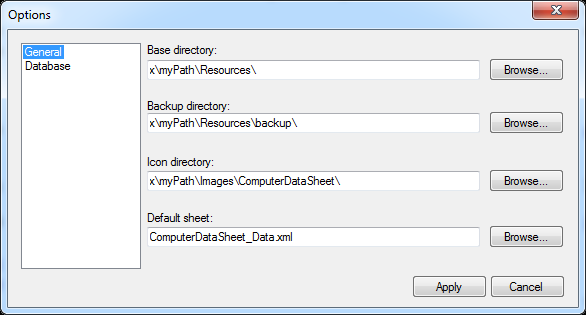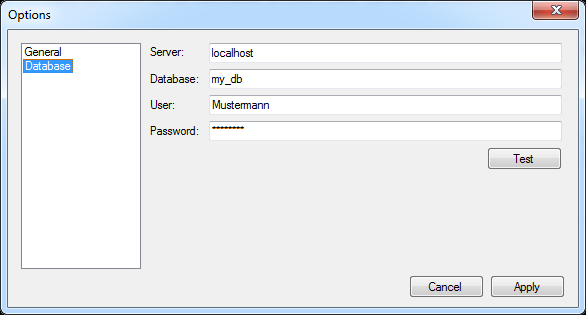Server - Computer Datasheet Editor
ComputerDataSheet plugin is used to display computer information depending on its type (desktop, server, etc.).
The tool is divided into two sections: Type Mapping and Sheet Configuration.
Overview
- Structure
- Configuration
- Type Mapping
- Create / edit data series
Structure
The Computer Datasheet Plugin consists of 3 + n XML files.
ComputerDataSheet_Data.xml
This file contains a standard configuration for easy generation of further data sheets.
ComputerDataSheet_DesktopData.xml
Here you can find a preconfigured data sheet for displaying required information of a desktop PC.
ComputerDataSheet_ServerData.xml
A preconfigured data sheet for displaying server data.
ComputerDataSheet_TypeMapping.xml
A preconfigured data sheet for the display of server dateThis file describes which data sheet is used for which device selection. This is controlled by an SQL query whose return value enables the recognition of the computer type.n.
Further data sheets for devices can be added as required at any time, and existing ones can be adapted to your own needs depending on the desired application. Each data sheet consists of a name and an SQL query for the desired type assignment. Part of each SQL query is the placeholder ResourceId, which then corresponds to the selected computer in the program.
A data series in the data sheet contains the following information:
- Icon
- Name constant
- activated/deactivated
The configuration is simple and comfortable with the help of the Computer Data Sheet Editor.
Here are the data series of the selected type assignment.
An edited data sheet is saved via  , new data series can be created with
, new data series can be created with  , [insert] or via the context menu. Not required by
, [insert] or via the context menu. Not required by  , [Delete] or via the context menu. The position of a row can be changed either by drag & drop or via the context menu. To edit an element selected either by double-click or with [Enter]. For a clearer display, you can use Filter-Combobox to set whether all, only activated, or only deactivated rows are to be displayed.
, [Delete] or via the context menu. The position of a row can be changed either by drag & drop or via the context menu. To edit an element selected either by double-click or with [Enter]. For a clearer display, you can use Filter-Combobox to set whether all, only activated, or only deactivated rows are to be displayed.
With ![]() the SQL queries of all displayed data series can be tested for functionality. Changes made in the data sheet are written to the associated file only after saving, and a backup of the last version is automatically created in the backup folder.
the SQL queries of all displayed data series can be tested for functionality. Changes made in the data sheet are written to the associated file only after saving, and a backup of the last version is automatically created in the backup folder.
Configuration
Under the General category, the basic paths for using the Computer Data Sheet are configured.
- Base directory The directory where the XML files are located.
- Backup directory The backups of the data sheets are stored in this directory. If no path is specified, backups are disabled.
- Icon directoryThe image files to be displayed are stored in this location.
- Default sheet The standard data sheet.
Database settings
The Database category is used to specify the database to be used.
The button ![]() can be used to test the entered connection data before saving.
can be used to test the entered connection data before saving.
Type Mapping
The type mapping describes which data sheet is used for which device selection.
The selection of the data sheet to be displayed is made via
New type assignments including data sheet can be added via  , no longer needed ones can be removed via
, no longer needed ones can be removed via  and the editing of the type assignment and the name is done with
and the editing of the type assignment and the name is done with  .
.
Create, edit type mapping
Each data sheet has its name and an SQL query for type assignment. Both can be adjusted at any time. When creating a new type assignment, you can set under Create from whether an empty data sheet should be created or whether the new data sheet should be derived from the standard or an existing data sheet.
For convenient editing, two tabs are available under the Query item: String and Result. In the String tab, the desired SQL query is entered and the input is visually supported by syntax highlighting. For an optimal display, the SQL query text can be formated with the help of the  button. The Result tab offers the possibility to test the SQL query directly and view the return value.
button. The Result tab offers the possibility to test the SQL query directly and view the return value.
Under Resource ID, all computers entered in the database are available for selection. Press to execute the SQL query and display a result or, in the case of an incorrect SQL query, an error message.
Create / edit data series
Each data series has its icon, name, enabled or disabled and SQL query. This data can be changed at any time. Here, too, the two tabs String and Result are available for editing the SQL query.
The desired SQL query is entered in the String tab and the input is visually supported by syntax highlighting. For an optimal display, the SQL query text can be formated with the help of the  button
button
The Result tab offers the possibility to test the SQL query directly and view the return value.
Under Resource ID all computers entered in the database are available for selection. With  the SQL query is executed and a result, or in case of an incorrect SQL query, an error message is displayed. While a data series is open, you can use
the SQL query is executed and a result, or in case of an incorrect SQL query, an error message is displayed. While a data series is open, you can use 
 to navigate through the data series set in the filter combo box. Multiple windows can be opened in parallel for editing and comparison.
to navigate through the data series set in the filter combo box. Multiple windows can be opened in parallel for editing and comparison.








